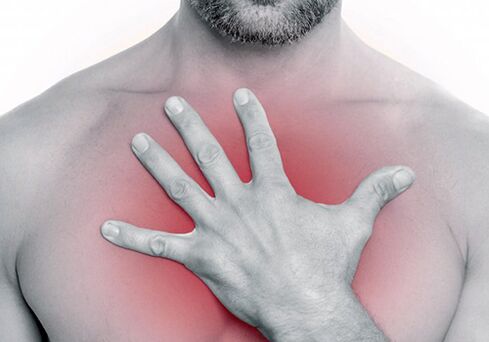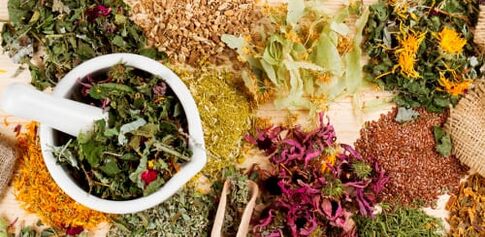
Degenerative and dystrophic changes in the tissues of the vertebrae and intervertebral discs and the clinical symptoms associated with these processes are called osteochondrosis.Let's consider the main causes and methods of treatment of osteochondrosis of the thoracic spine.
Causes of osteochondrosis of the thoracic spine
- Inheritance.
Damaged or mutated genes responsible for normal bone growth are inherited.Therefore, the risk of osteochondrosis increases significantly if there are people suffering from this disease in the family. - Sedentary lifestyle.
In this case, prolonged and excessive load on the spine is important, which leads to compression of the vertebrae and the development of the disease.This happens more often among people working at computers and drivers. - Vascular pathology.
Any disease of the vessels supplying blood to the spine and leading to insufficient supply of nutrients to the vertebral tissue leads to the appearance of degenerative and dystrophic changes in them. - Metabolic disorders in the body.
Most often, diabetes mellitus leads to changes in blood vessels that disrupt tissue trophism.In addition, direct changes in the vertebral tissue are possible in disorders of the phosphorus-calcium metabolism, in diseases of the thyroid and parathyroid glands, and in diseases of the adrenal cortex. - Infections and poisonings.
Inflammatory processes in the tissue of the vertebrae and intervertebral discs, caused by viruses, bacteria or the effects of their toxins, can also lead to the development of osteochondrosis. - Overweight.
The presence of constant excessive load on the spine leads to compression of the intervertebral discs with the subsequent development of the processes underlying osteochondrosis. - Poor diet.
A deficiency of microelements (for example, calcium) and a deficiency of vitamins (D3) can also lead to a disruption in metabolic processes in the body and the development of pathology of bone and cartilage tissue. - Age-related changes in bone and cartilage tissue.
With increasing age, degenerative changes occur in the thoracic spine, which lead to compression of the intervertebral discs.As we age and age, the muscular structure of the spine also weakens. - Injuries to the thoracic spine.
Bruises and fractures of the vertebral arches due to a fall or car injury are not uncommon.At the same time, anatomical changes in the vertebrae and surrounding tissues are the direct cause of the development of the pathological process that is the cause of osteochondrosis. - Scoliosis
“School pathology”, which develops in children of educational institutions where health-saving technologies are not used, occurs mainly in the thoracic spine.Due to the curvature of the spine, the load on individual spinal segments changes significantly, which leads to the development of osteochondrosis. - Sports and occupational dangers.
Sporting stress (e.g. weightlifting) as well as work associated with heavy lifting, frequent changes in posture (twisting, bending and stretching, jerky movements) can also lead to persistent pathological changes in the spine.In addition, prolonged exposure to uncomfortable postures while standing, sitting, lying down, lifting and carrying heavy objects, or other work that increases the pressure in the intervertebral discs and the load on the entire spine can also lead to osteochondrosis. - Other causative factors and risks of developing osteochondrosis of the thoracic spine.
Overuse of the spine associated with foot diseases, but also from wearing uncomfortable shoes, high heels and pregnancy in women, an abrupt cessation of regular training by professional athletes and finally nervous overexertion and stressful situations.
Symptoms of osteochondrosis of the thoracic spine
All symptoms of the disease can be divided into reflex and compression.
Reflex symptoms
The mechanism of their occurrence is irritation of the receptors of the intervertebral ligaments, the capsules of the intervertebral joints and the receptors of the intervertebral discs.The radiation (spread) of irritation to neighboring spinal cord segments can lead to the appearance of various symptoms.
Here are the most important ones: chest pain, pain in the stomach or in the heart area, tension in the chest muscles, vegetative symptoms of the internal organs.The pain is always stabbing and is described by patients as a dagger blow.The location of the pain is the area between the shoulder blades; the pain can radiate to the heart area, the breastbone.
It may be difficult for the patient to move at all or take deep breaths.Reflex symptoms in osteochondrosis of the thoracic spine occur significantly more often than compression symptoms.
Compression symptoms
Compression symptoms of osteochondrosis of the thoracic spine are caused by compression or stretching of the nerve root in the area of its exit from the intervertebral foramen.The main ones are: symmetrical muscle weakness in both legs, loss of sensation in them, “radicular” pain in the back and chest.The pain “shoots”, is felt in the chest, in the stomach and increases with movement, bending the body, coughing, sneezing, laughing.There is a feeling of tingling, numbness and tingling.As the pathology develops, movement disorders and muscle atrophy may occur.Muscle tone increases, sensitivity of the lower extremities decreases, and urination disorders may occur.
Other autonomic symptoms of osteochondrosis of the thoracic spine
Autonomic symptoms in osteochondrosis occur due to the fact that the nerve fibers coming from the thoracic spine contain autonomic conductors;Irritation or injury to these fibers can result in vegetative symptoms.The main ones are: peeling and dry skin in the innervation zone of the compressed nerve, local disturbance of sweating and thermoregulation (also depending on the innervation zone), brittle toenails, pain simulating the pathology of the gastrointestinal tract (gastritis, peptic ulcer, cholecystitis), pain in the lower back, pain in the heart.
Treatment of osteochondrosis of the thoracic spine
Treatment of osteochondrosis of the thoracic spine should be comprehensive (using a combination of drug and non-drug methods), individual and systemic.
Drug treatment methods for osteochondrosis of the thoracic spine
The main goals of these methods are to eliminate pain and muscle tension, as well as improve microcirculation and tissue trophism.For this purpose, non-steroidal anti-inflammatory drugs are used to reduce inflammation, eliminate pain and muscle tension.These funds are prescribed for an average of 7-14 days.Local anesthetic applications are prescribed.If non-steroidal analgesics have an insufficient effect, a painkiller mixture is used.The mixtures are administered intravenously with saline or glucose.Paravertebral blocks have a rapid analgesic effect when an analgesic is injected into the soft tissue of the perivertebral areas.
To relieve pain in osteochondrosis of the thoracic spine, irritating and distracting ointments are applied topically.
Muscle tension is relieved by medications such as muscle relaxants.
To normalize blood circulation and improve tissue nutrition, antiplatelet drugs and nicotinic acid are used.
They also use drugs that improve metabolism in intervertebral discs and joints - chondroprotectors.
Non-drug treatments
Diet for osteochondrosis of the thoracic spine.Completely excluded from the diet: salt, hot spices, preparations with vinegar and salt, semi-finished products, sugar (can be replaced with honey), coffee and carbonated drinks.The following are allowed: legumes, eggplant, cheese, dairy products, lettuce, cabbage, cottage cheese, bananas, liver, carrots, melon, seafood, grains, fresh vegetables and fruits, herbs, seeds and berries.
The complex treatment program for osteochondrosis of the thoracic spine includes: manual therapy, classical massage, acupressure, reflex segmental massage, physiotherapy, torsion techniques (stretching), acupuncture, swimming, physiotherapeutic methods (electrophoresis, ultrasound, amplipulse, diodynamic currents, mud therapy and others, etc.).
Traditional methods of treating osteochondrosis of the thoracic spine

Exacerbation of osteochondrosis of the thoracic spine is an indication for treatment under strict medical supervision.Home and folk remedies should never be used blindly and without a doctor's permission.As additional treatment to alleviate the patient's condition, the following measures can be used:
- Tinctures and decoctions.
- Tincture of lingonberry leaves.Take 1 tablespoon of lingonberry leaves, pour 0.25 liters of boiling water and let it brew for 2 hours.Drink half a glass in the morning and evening for 3 weeks.
- A decoction of parsley roots.Grind 50 g of parsley roots, add 0.5 liters of water and simmer over low heat for an hour and a half.Consume 1 tablespoon each morning and evening for 3 weeks.
- Tincture of nettle and honey.Squeeze the juice from freshly picked nettles and mix it with equal parts honey and medicinal alcohol.Leave in a cold place for 14 days and consume one tablespoon in the morning on an empty stomach for 2 weeks.
- Yarrow tincture with mint, licorice and marigold.Mix a tablespoon of yarrow and 2 tablespoons of mint, licorice and calendula and pour 1 liter of boiling water, let it brew for 7-8 hours.Take 50 ml three times a day for 3 weeks.
- Rub.
- Radish and honey infused with vodka.Grate the radish, mix it with honey in equal parts and add 50 ml of vodka.Use this composition to rub on the site of pain.
- pork fat and hops.Mix a tablespoon of melted pork fat, cooled to room temperature, with an equal amount of ground hops.Rub the resulting composition into the affected area.
- pork fat and propolis.Melt 150 g of pork fat, add 30 g of propolis and mix thoroughly.It is best to rub the skin at night.After the procedure, you should wrap your back with a warm cloth.
- Ginger and garlic.Fry chopped ginger and garlic with the addition of butter until a homogeneous paste is formed.Rub the resulting mixture onto the painful area.
- Oregano with oil.Mix 1 tablespoon of oregano and 0.2 liters of olive oil.Leave the mixture on for 10 hours, then strain and rub into the painful areas of the back.
Prognosis of osteochondrosis of the thoracic spine
The prognosis is generally favorable and complications are rare with this form of the disease.It is worth paying attention to the timely diagnosis of the disease, excluding other pathologies of the chest organs, as well as completing treatment and sufficiently preventing exacerbations of osteochondrosis.



























